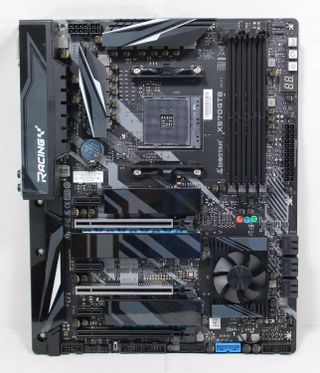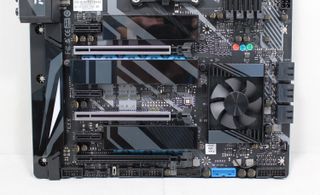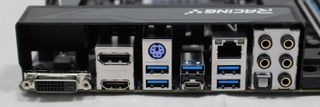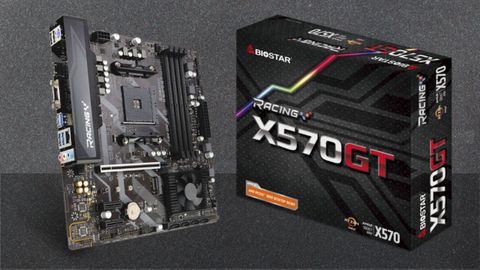Tom's Hardware Verdict
Biostar’s current sole X570 board is the least-expensive option that includes three heatsink-covered M.2 slots, while still including six SATA ports. Stock performance is on par with the competition, but overclocking was a bit of a disappointment. It’s a solid choice for builds focused on storage, but I wonder how it will handle overclocking future high-end Ryzen CPUs.
Pros
- +
Onboard power/reset buttons
- +
Debug LEDs
- +
All M.2 slots include a heatsink
Cons
- -
No front-panel USB 3.1 Gen2 port
- -
No Wi-Fi
Why you can trust Tom's Hardware
Features and Specifications
In our recent deep-dives into a couple of the least-expensive X570 motherboards (the Asus TUF Gaming X570-Plus Wi-Fi and the Gigabyte X570 Aorus Elite), we saw good results for boards in the roughly $200 price range. But now it’s time to step up just a bit and check out the $230 Biostar X570GT8 (current UK pricing ranges from under £200 to nearly £300, likely due to stock availability issues). The Biostar GT8 includes three PCIe 4.0 M.2 slots, USB 3.1 Gen 2 Type-C port on the rear IO, RGB LEDs, and a 12-phase VRM designed to handle the latest high-end Ryzen 3000 series CPUs.
Biostar’s motherboard options are typically limited in both the Intel and AMD camps, often with only a couple of boards coming out for most of the chipsets. At the time of this writing, the X570GT8 is the only X570 board available from the company, hailing from the 4th generation Racing series line. On the older X470 chipset, the company has a total of four boards, including an Mini-ITX option. So we do expect to see other X570-based motherboards from Biostar in time.
The Biostar X570GT8’s $230 MSRP places it in the lower range of all X570 boards. We had an overall positive experience in building and testing, although our overclocking results were just a tik lower than the other X570 motherboards we looked at so far.
Performance was where we expected it to be, trading blows with other X570 boards, so no complaints there. The BIOS is a little different than the other AIBs, with the tweaking section (O.N.E) at the far right instead of the left side where we normally see it. If you are using multiple PCIe NVMe drives, the three full speed slots and heatsinks are a welcome sight.
As with other boards on this platform, the X570GT8 supports both Ryzen 2000 and Ryzen 3000 series processors. It includes six SATA ports and four DIMM slots capable of supporting up to 128GB of DDR4 RAM at rated speeds to DDR4 4000(OC). For networking and audio, we find an Intel I211AT NIC and the premium Realtek ALC1220 S1200A audio codec. Below is a complete list of specifications from Biostar.
Specifications
| Socket | AM4 |
| Chipset | AMD X570 |
| Form Factor | ATX |
| Voltage Regulator | 12 phase/8+4 (4+2 doubled actual) |
| Video Ports | HDMI 1.4bDisplayPortDVI-D |
| USB Ports | USB 3.1 Gen 2 (10 Gbps): 1x Type-A, 1x Type-CUSB 3.1 Gen 1 (5 Gbps): 4x Type-A |
| Network Jacks | (1) Gigabit Ethernet |
| Audio Jacks | (5) Analog + SPDIF |
| Legacy Ports/Jacks | ✗ |
| Other Ports/Jack | ✗ |
| PCIe x16 | (1) v4.0 |
| PCIe x8 | (1) v4.0 |
| PCIe x4 | (1) v4.0 |
| PCIe x1 | (2) v4.0 |
| CrossFire/SLI | AMD CrossfireX |
| DIMM slots | (4) DDR4 |
| M.2 slots | (3) PCIe 4.0 x4 / SATA + PCIe |
| U.2 Ports | ✗ |
| SATA Ports | (6) 6Gb/s |
| USB Headers | (2) v3.x Gen1, (2) USB v2.0 |
| Fan Headers | (5) 4-Pin |
| Legacy Interfaces | PS/2 |
| Other Interfaces | FP-Audio, RGB-LED, TPM |
| Diagnostics Panel | Debug LED |
| Internal Button/Switch | Power / Reset / Reset CMOS |
| SATA Controllers | ✗ |
| Ethernet Controllers | Intel i211AT |
| Wi-Fi / Bluetooth | ✗ |
| USB Controllers | ✗ |
| HD Audio Codec | Realtek ALC1220 |
| DDL/DTS Connect | ✗ / ✗ |
| Warranty | 3 Years |
The included accessories are minimal (no Biostar racing stickers?!?) but the company includes what you need to get started. Here’s a list of what ships in the box, along with the board.
- User’s manual
- I/O Shield
- Support DVD
- 4x SATA cables


When looking at the X570GT8’s styling, it follows the company’s existing racing line, but with a new “lightning strikes” design. The PCB is black, with a grey design feature running throughout most of the board including on the M.2 heatsinks. The chipset fan is larger than we have seen on other boards, though the design of the heatsink itself a simple rectangle with the fan in the middle. The rear IO and audio shroud is where the integrated RGB LEDs are located.
The VRM heatsinks look like they will do the job, but are smaller than on some other less-expensive boards. On top of these are more of the same design accents we see on the bottom part of the board. All of the DIMM slots and PCIe slots are black, matching the board with the two primary PCIe slots using reinforcement.
The black and white board shouldn’t have an issue meshing with most build themes. The conservative use of RGB lighting is a plus for some. If you need more, the board also has a couple of RGB headers (moe on that later). Any RGB illumination is controlled through Biostar’s Racing GT Evo software and the Vivid LED DJ section.

Zooming in on the top half of the motherboard, there’s a fair bit to talk about. Starting on the side we see a shroud covering the rear IO bits. Uniquely, the shroud is made out of aluminum, where most are plastic. Biostar says this helps reduce EMI of the underlying parts. Also located on the shroud is the Racing branding which is illuminated from below by RGB LEDs.
We can see the dual 8-pin (required) and 4-pin (optional) EPS connectors up here, which sends power to the 12-phase VRM. This board uses an Infineon 8 phase controller running in 4+2 mode using phase doublers on the CPU side to reach 8 phases. On paper, this board shouldn’t have any issues overclocking the Ryzen 3000 CPUs. The heatsinks are capable, but note that the top middle motherboard mounting hole is covered by the heatsink. Using eight screws is plenty, but this was a design oversight.
To the right of the socket and VRM area are four DIMM slots, which use a single-sided locking mechanism to keep the memory secured. Memory support is up to 128GB across those four slots with speeds up to DDR4 4000 when overclocking. Your mileage may vary as far as how high memory can go as it depends on the sticks used as well as the quality of the IMC on the chip.
Also by the DIMM slots is one of five fan headers on the board. The second is located just above the top PCIe x1 slot. The fan headers are of the hybrid variety,supporting both PWM- and DC-controlled fans.
On the far right side of the board is the 24-pin ATX connector to feed power to the motherboard. Above that is the 2 character debug LED, helpful for troubleshooting any boot issues. This type of debug LED is gives more information about the error than the simple ‘dummy’ lights we saw on the less-expensive X570 boards. Above that are three buttons: one for power, the second for reset and the third clear the CMOS. As someone who benchmarks on an open bench table, these buttons are invaluable. For the majority who use a case with the motherboard inside, these can be convenient when troubleshooting, but aren’t otherwise likely to be used often.
Last but not least are two RGB headers in the upper-right corner. The top is a 3-pin 5V addressable header which connects up to 300 individually addressable RGB LEDs, with a maximum power rating of 3A (5V). The 12V LED connector supports 5050 RGB LED strips, also with a 3A (12V) rating. Control over the attached strips is managed by the Vivid LED DJ software.

Moving on to the bottom half of the X570GT8, the left side where the audio sits is covered with a shroud -- or as biostar calls it, “audio armor.” Inside the audio armor is the second location of on-board RGB LEDs. The white portion of the pattern is illuminated through LEDs connected to the shroud/armor. Below this is where the premium Realtek ALC1220 audio chip sits, along with what the company calls “double Hi-Fi” AMP IC for headphones. Compared to the budget X570 boards we’ve reviewed, it’s nice to see high-end audio on a motherboard again, though we do expect it at this level of board.
The PCIe area is a bit more busy here, with three full-length PCIe slots and three x1 slots. The primary slots are reinforced with Biostar’s meal “armor,” which helps prevent slot shearing or cracking under the weight of heavy cards, and can also minimize EMI. The top runs at a full PCIe 4.0 x16, while the second slot runs at a maximum of x8 mode. The last full-length slot runs at x4 (note that these speeds apply when running 3rd gen Ryzen CPUs). The three 1x slots run at x1 speeds.
Between the PCIe slots are three, yes three, M.2 slots. All of these slots are able to run PCIe 4.0 x4 speeds. PCIe M2_1 supports only PCIe M.2 modules while PCIe M2_2 and M2_3 support both PCIe and SATA drives. Slots M2_1 and M2_3 support up to 80mm modules with M2_2 supporting the larger 110mm drives. All slots are able to give the full PCIe 4.0 x4 bandwidth without losing any SATA ports. While many higher-end boards have three M.2 slots, not all of them come with heatsinks as these do, and it’s a welcome feature aesthetically, as well as providing some welcome cooling for hot-running NVMe based drives.
Moving to the right, we then see the chipset heatsink and fan. On the other X570 boards I’ve tested to date, the fan is quite small. Here, the fan is a bit bigger and also completely open, exposing the whole fan. There are fins on the top and bottom of the heatsink for more surface area. This setup isn’t the most appealing to the eye, but does the job and does so quietly.
To the right of the heatsink area are six SATA3 ports. The chipset supports eight total. But because of the three M.2 slots, two were taken away. This prevents any necessary sharing of bandwidth. I like this setup as these days M.2 drives, be it SATA or PCIe NVMe based, are becoming more common, making the six SATA ports here more than adequate for most builds.
Something also worth noting is the LN2 switch found near the bottom-right corner of the chipset heatsink. When enabled, this will force the CPU to run at 800 MHz, which the manual says is to avoid unexpected system shutdown. While this is a cool feature on a lower-cost board such as this, this board isn’t likely to be the weapon of choice for sub-ambient overclocking and really pushing limits.
On the very bottom edge of the board are several different headers and buttons including USB, fan, CMOS jumper and more. There isn’t anything exceptional to share here, but we list them all below.
- Front Panel Audio
- 2x Fan headers
- CMOS jumper
- Dual BIOS switch
- 2x USB 2.0 headers
- USB 3.1 header
- USB 3.2 header (fast charge)
- Front panel header
- Front panel header
- Clear CMOS jumper

Moving on to the rear IO area, one of the first things I noticed is the Biostar X570GT8 does not include an integrated IO plate. We’ve seen Gigabyte boards step up and add these, even in one of its lowest priced boards. That said, the IO plate included in the box is black with the “racing” name on it, and it looks good when in place.
Ports on the rear IO include video outputs, USB, network, and the audio stack. Surprisingly, we see three different video outputs here, DVI-D, DisplayPort and HDMI. These are used only if an APU (like the Ryzen 5 3400G is in the socket). There are a total of four USB 3.1 Gen 1 (5 Gbps) Type-A ports and two USB 3.1 Gen 2 ports -- one of the latter is Type-A and the other Type-C. We can also see the Intel LAN port as well as a legacy PS/2 port back here. The audio stack contains five 7mm plugs and an S/PDIF plug as well.
I like the 10 Gbps Type-C port out back, but would like to see more USB ports in general. The three video ports take up lots of space, especially given that they’re only ever going to be used by a subset of builders, who could probably get by with one or two video connectors anyway.

MORE: Best Motherboards
MORE: How To Choose A Motherboard
MORE: All Motherboard Content

Joe Shields is a Freelance writer for Tom’s Hardware US. He reviews motherboards.
-
bramahon Biostar makes, or at least used to make, good motherboards at an affordable price. I know for many this may come as a surprise but their high-end boards generally have quality components. Where these lack is in BIOS/Software and the overall polish. I took a big chance on their T-Power X-58, a decade ago, and guess what it's still functional with a 920! The board had lots of quirks and an unfriendly BIOS, nonetheless was a fine overclocker with excellent VRM heatsinks.Reply -
hristohh Reply
The fan curve is adjustable via the BIOS. It can be turned off at lower temperatures.philipemaciel said:Does the chipset fan spin all the time, or only when the board gets hot?
